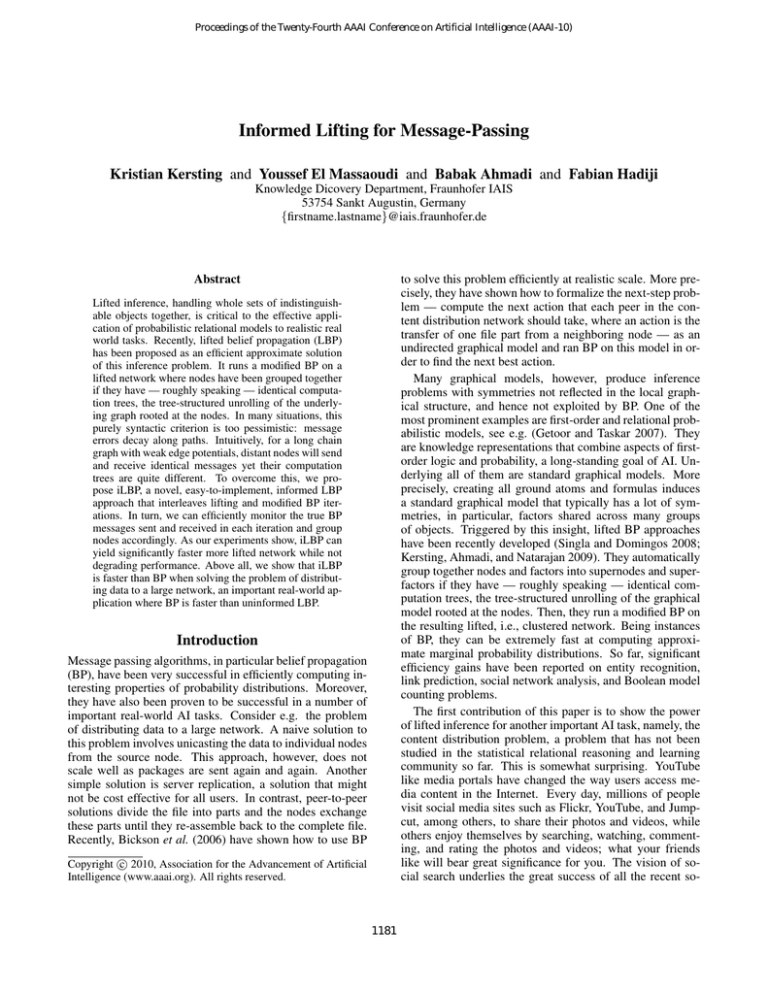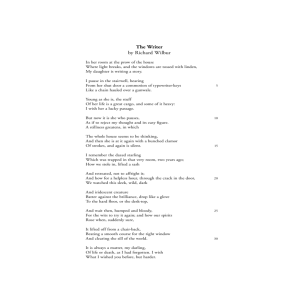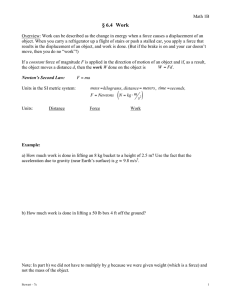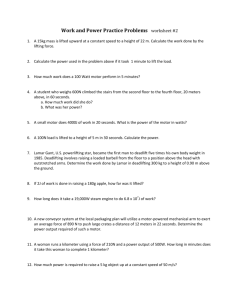
Proceedings of the Twenty-Fourth AAAI Conference on Artificial Intelligence (AAAI-10)
Informed Lifting for Message-Passing
Kristian Kersting and Youssef El Massaoudi and Babak Ahmadi and Fabian Hadiji
Knowledge Dicovery Department, Fraunhofer IAIS
53754 Sankt Augustin, Germany
{firstname.lastname}@iais.fraunhofer.de
Abstract
to solve this problem efficiently at realistic scale. More precisely, they have shown how to formalize the next-step problem — compute the next action that each peer in the content distribution network should take, where an action is the
transfer of one file part from a neighboring node — as an
undirected graphical model and ran BP on this model in order to find the next best action.
Many graphical models, however, produce inference
problems with symmetries not reflected in the local graphical structure, and hence not exploited by BP. One of the
most prominent examples are first-order and relational probabilistic models, see e.g. (Getoor and Taskar 2007). They
are knowledge representations that combine aspects of firstorder logic and probability, a long-standing goal of AI. Underlying all of them are standard graphical models. More
precisely, creating all ground atoms and formulas induces
a standard graphical model that typically has a lot of symmetries, in particular, factors shared across many groups
of objects. Triggered by this insight, lifted BP approaches
have been recently developed (Singla and Domingos 2008;
Kersting, Ahmadi, and Natarajan 2009). They automatically
group together nodes and factors into supernodes and superfactors if they have — roughly speaking — identical computation trees, the tree-structured unrolling of the graphical
model rooted at the nodes. Then, they run a modified BP on
the resulting lifted, i.e., clustered network. Being instances
of BP, they can be extremely fast at computing approximate marginal probability distributions. So far, significant
efficiency gains have been reported on entity recognition,
link prediction, social network analysis, and Boolean model
counting problems.
The first contribution of this paper is to show the power
of lifted inference for another important AI task, namely, the
content distribution problem, a problem that has not been
studied in the statistical relational reasoning and learning
community so far. This is somewhat surprising. YouTube
like media portals have changed the way users access media content in the Internet. Every day, millions of people
visit social media sites such as Flickr, YouTube, and Jumpcut, among others, to share their photos and videos, while
others enjoy themselves by searching, watching, commenting, and rating the photos and videos; what your friends
like will bear great significance for you. The vision of social search underlies the great success of all the recent so-
Lifted inference, handling whole sets of indistinguishable objects together, is critical to the effective application of probabilistic relational models to realistic real
world tasks. Recently, lifted belief propagation (LBP)
has been proposed as an efficient approximate solution
of this inference problem. It runs a modified BP on a
lifted network where nodes have been grouped together
if they have — roughly speaking — identical computation trees, the tree-structured unrolling of the underlying graph rooted at the nodes. In many situations, this
purely syntactic criterion is too pessimistic: message
errors decay along paths. Intuitively, for a long chain
graph with weak edge potentials, distant nodes will send
and receive identical messages yet their computation
trees are quite different. To overcome this, we propose iLBP, a novel, easy-to-implement, informed LBP
approach that interleaves lifting and modified BP iterations. In turn, we can efficiently monitor the true BP
messages sent and received in each iteration and group
nodes accordingly. As our experiments show, iLBP can
yield significantly faster more lifted network while not
degrading performance. Above all, we show that iLBP
is faster than BP when solving the problem of distributing data to a large network, an important real-world application where BP is faster than uninformed LBP.
Introduction
Message passing algorithms, in particular belief propagation
(BP), have been very successful in efficiently computing interesting properties of probability distributions. Moreover,
they have also been proven to be successful in a number of
important real-world AI tasks. Consider e.g. the problem
of distributing data to a large network. A naive solution to
this problem involves unicasting the data to individual nodes
from the source node. This approach, however, does not
scale well as packages are sent again and again. Another
simple solution is server replication, a solution that might
not be cost effective for all users. In contrast, peer-to-peer
solutions divide the file into parts and the nodes exchange
these parts until they re-assemble back to the complete file.
Recently, Bickson et al. (2006) have shown how to use BP
c 2010, Association for the Advancement of Artificial
Copyright Intelligence (www.aaai.org). All rights reserved.
1181
cial platforms. However, while many of these services are
centralized, i.e., rely on server replication, the full flexibility of social information-sharing can often be better realized
through direct sharing between peers. So, the question naturally arise ”Does Bickson et al.’s graphical model for solving the next-step problem also produce inference problems
with symmetries not reflected in the graphical structure?”
An investigation of this question was the seed that grew into
our main contribution: informed lifted BP.
In fact, simply applying lifted BP (LBP) to Bickson et
al.’s graphical model did not succeed. Although there are
symmetries exploitable for lifting, standard BP runs simply
too quickly: it often converges within few iterations. In contrast, LBP’s preprocessing step for lifting the network takes
more iterations, does not produces any belief estimates, and
may yield lifted networks that are too pessimistic. The situation is depicted in Fig. 1. It shows the error curves of
running (L)BP on a local snapshot of a real-word file sharing network. As one can see, BP only takes 5 iterations,
whereas lifted BP first takes 7 iterations of a color-message
passing scheme to compute the lifted network and only then
runs 5 highly efficient iterations simulating BP on the lifted
network. This is slower than BP because:
Figure 1: Max-norm of belief estimates vs. number of iterations of (L)BP on a factor graph representing the collaboration graph of a local snapshot of the Gnutella network
(1374 nodes, 4546 edges). BP converges within 5 iterations.
LBP first lifts the network using color-passing (7 iterations)
without estimating any beliefs at all; then it runs the highly
efficient modified BP on the lifted network. (Best viewed in
color)
ference approaches are extremely complex, so far do not easily scale to realistic domains, and hence have only been applied to rather small artificial problems. Shavlik and Natarajan (2009) proposed a preprocessing algorithm that can reduce the effective size of Markov logic networks (Richardson and Domingos 2006) and, hence, can speed up greatly
inference. All of these approaches, however, require a firstorder logical specification of the model; iLBP does not.
Recently, Sen et al. (2008; 2009) presented a lifted variable elimination approach based on bisimulation. As iLBP,
it essentially uses identical computation trees to group together indistinguishable objects. In contrast to the previous
approaches, however, it does not require a first-order logical
specification. The simplest and hence most efficient lifted
inference approaches are the already mentioned lifted belief
propagation approaches. They easily scale to realistic domains. Motivated by Jaimovich et al. (2007), Singla and
Domingos (2008) developed the first lifted belief propagation variant requiring a Markov logic network as input. Subsequently, Kersting et al. (2009) generalized it to any factor
graph over discrete, finite variables. Both of them perform
lifting in an uninformed fashion and have not been used for
solving the content distribution problem.
Probably the closest work to iLBP is de Salvo Braz et
al.’s (2009) anytime LBP. It also performs lifting during
message passing. In contrast to iLBP, however, it uses box
(and not belief) propagation only on a subset of the model,
but with supernodes, as in lifted BP. It also requires a firstorder logical specification.
• Computing the color-messages often takes essentially as
much time as computing the BP messages, in particular
for discrete nodes with few states and low degree.
• The lifting step is purely syntactic. Colors only denote the
nodes and factors producing BP messages. Neither BP
messages nor any belief estimates are actually computed.
• In turn, LBP cannot make use of the fact that BP message errors decay along paths (Ihler, Fisher III, and Willsky 2005) already at lifting time. It may spuriously assume some nodes send and receive different messages
and, hence, produce pessimistic lifted network.
Informed lifted BP (iLBP) overcomes these problems. It is
a novel, easy-to-implement, lifted BP approach that tightly
interleaves lifting and modified BP iterations. This allows
one to efficiently monitor the true BP messages sent and received in each iteration and to group nodes accordingly. As
our experiments show, significant efficiency gains are obtainable: iLBP can yield significantly faster higher lifted
network while not degrading performance. Above all, we
show that iLBP is faster than BP when solving the problem
of distributing data to a large network of fixed, known topology, an important real-world application where BP is faster
than (uninformed) LBP.
We proceed as follows. After touching upon related work,
we briefly review LBP. Then, we introduce iLBP and prove
its correctness. Before concluding, we present our experimental results including an evaluation of iLBP for the content distribution problem in real-world networks.
Lifted Belief Propagation
Related Work
Let X = (X1 , X2 , . . . , Xn ) be a set of n discrete-valued
random variables each having d states, and let xi represent
the possible realizations of random variable Xi . Graphical models compactly represent a joint distribution over X
as a product of factors (Pearl 1991), i.e., P (X = x) =
Recent years have witnessed a surge of interest in lifted
probabilistic inference. Poole (2003), de Salvo Braz et
al. (2005), and Milch et al. (2008) have developed lifted versions of the variable elimination algorithm. These exact in-
1182
Although already quite efficient, many graphical models
produce factor graphs with symmetries not reflected in the
graphical structure. Reconsider the factor graph in Fig. 2.
The associated potentials are identical. Lifted BP (LBP) can
make use of this fact. Essentially, as e.g. described in (Kersting, Ahmadi, and Natarajan 2009), it performs two steps:
Given a factor graph G, it first computes a compressed factor graph G and then runs a modified BP on G. (We use
fraktur letters such as G, X, and f to denote the lifted, i.e.,
compressed graphs, nodes, and factors).
(Step 1) Lifting by Color-Passing (CP): Initially, all
variable nodes fall into the d+1 groups (one or more of these
may be empty), namely known state s1 , . . . , known state sd ,
and unknown. For ease of explanation, we will represent the
groups by colors (respectively shades). All factor nodes with
the same associated potentials also fall into one group represented by a color. Now, each variable node sends a message
to its neighboring factor nodes saying “I am of color C”. A
factor node sorts the incoming colors into a vector according
to the order the variables appear in its arguments. The last
entry of the vector is the factor node’s own color. This color
signature is sent back to the neighboring variables nodes, essentially saying “You have communicated with these kinds
of nodes”. The variable nodes stack the incoming signatures
together and, hence, form unique signatures of their one-step
message history. Variable nodes with the same stacked signatures are grouped together, and a new color is assigned
to each group. The factors are grouped in a similar fashion based on the incoming color signatures of neighboring
nodes. This CP process is iterated until no new colors are
created anymore. As the effect of the evidence propagates
through the factor graph, more groups are created.
The final lifted graph G is constructed by grouping all
nodes (factors) with the same color (signatures) into supernodes (superfactors). Supernodes (superfactors) are sets of
nodes (factors) that send and receive the same messages at
each step of carrying out BP on G and form a partition of
the nodes in G.
(Step 2) Modified BP (MBP) on the Lifted Graph1 :
The basic idea is to run a modified BP on G that simulates
BP on G. An edge from a superfactor f to a supernode Xi in
G essentially represents multiple edges in G. Let c(f, Xi ) be
the number of identical messages that would be sent from
the factors in the superfactor f to each node in the supernode Xi if BP was carried out on G. The message from a
supervariable X to a superfactor f is µX→f (x) =
Y
µf→X (x)c(f,X)−1 ·
µh→X (x)c(h,X)
Figure 2: An example for a factor graph — a chain graph
model with n + 1 nodes — with associated potentials. Circles denote variables, squares denote factors.
Q
Z −1 k fk (xk ) . Each factor fk is a non-negative function
of a subset of the variables xk , and Z is a normalization constant. If P (X = x) > 0 for all joint configurations x, the
distribution can be equivalently represented
as a log-linear
P
model: P (X = x) = Z −1 exp [ i wi · gi (x)], where the
factors gi (x) are arbitrary functions of (a subset of) the configuration x. Each graphical model can be represented as a
factor graph. A factor graph, cf. Fig 2, is a bipartite graph
that expresses the factorization structure of the joint distribution. It has a variable node (denoted as a circle) for each
variable Xi , a factor node (denoted as a square) for each fk ,
with an edge connecting variable node i to factor node k if
and only if Xi is an argument of fk . We assume one factor
fi (x) = exp [wi · gi (x)] per feature gi (x).
An important (#P-complete) inference task is to compute
the conditional probability of variables given the values of
some others, the evidence, by summing out the remaining
variables. The belief propagation (BP) algorithm is an efficient way to solve this problem that is exact when the factor
graph is a tree, but only approximate when the factor graph
has cycles. Although this loopy BP has no guarantees of
convergence or of giving the correct result, in practice it often does, and can be much more efficient than other methods (Murphy, Weiss, and Jordan 1999).
BP can elegantly be described in terms of operations on a
factor graph. To do so, we first introduce messages between
variable nodes and their neighboring factor nodes and vice
versa. The message from a variable X to a factor f is
Y
µX→f (x) =
µh→X (x)
h∈nb(X)\{f }
where nb(X) is the set of factors X appears in. The message
from a factor to a variable is
X
Y
f (x)
µf →X (x) =
µY →f (y)
¬{X}
h∈nb(X)\{f}
where nb(X) now denotes the neighbor relation in the lifted
graph G. The c(f, X) − 1 exponent reflects the fact that a
supervariable’s message to a superfactor excludes the corresponding factor’s message to the variable if BP was carried out on G. Finally, the unnormalized belief of Xi , i.e.,
of any node
Q X in Xi can be computed from the equation
bi (xi ) = f∈nb(Xi ) µf→Xi (xi )c(f,X) . Evidence is incorporated as in standard BP.
Y ∈nb(f )\{X}
where nb(f ) are the arguments of f , and the sum is over
all of these except X, denoted as ¬{X}. The messages are
usually initialized to 1, and the unnormalized belief of each
variable
Xi can be computed from the equation bi (xi ) =
Q
f ∈nb(Xi ) µf →Xi (xi ) . Evidence is incorporated by setting
f (x) = 0 for states x that are incompatible with it. Different
schedules may be used for message-passing.
1
For the sake of simplicity, we present simplified equations that
neglect the positions a supernode may appear in a superfactor.
1183
Algorithm 1: iLBP – informed Lifted BP. We use bi (xi )
resp. mi (xi ) to denote the unnormalized beliefs resp.
messages of both variable node Xi and variable nodes
covered by supernodes Xi .
Data: A factor graph G with variable nodes X and
factors f , Evidence E
Result: Unnormalized marginals bi (xi ) for all
supernodes and, hence, for all variable nodes
1 Colorize X and f w.r.t. E;
2 G ← one iteration CP;
3 Initialize messages for G;
4 (bi (xi ), mi (xi )) ← one iteration MBP on G;
5 Colorize all Xi s according to mi (xi );
6 while bi (xi )s have not converged do
7
G0 ← one iteration CP (based on new colors);
8
Initialize novel supernodes using bi (xi ) and mi (xi );
9
(bi (xi ), m(xi )) ← one iteration of MBP on G0 ;
10
foreach supernode X in G do
11
if the m(xi )s of the Xi s in X differ then
12
Colorize all Xi in X according to m(xi )
Figure 3: Supernodes — indicated by the colors of the original nodes — produced by uninformed (top) and informed
(bottom) lifting on a chain graph model with n + 1 nodes
and identical, weak edge potentials. Factors have been omitted. Uninformed lifting produces n/2 − 1 many supernodes
whereas informed lifting takes advantage of decaying message errors and produces only 2 supernodes: one for the end
nodes of the chain and one for the other nodes.
Informed Lifting
Let us analyze how LBP behaves on the simple chain model
from Fig. 2, now assuming weak (but still identical) edges
potentials. The lifted graph produced by LBP is shown in
Fig. 3 (top). Due to the purely syntactic ”lifting” criterion
used by CP — group nodes according to identical (colored)
computation trees, the tree-structured unrolling of the underlying graph rooted at the nodes — nodes with the same
distance to one of the ends of the chain are grouped together.
Consequently, n/2 + 1 many supernodes are produced. Can
we do any better?
It was shown by Ihler et al. (2005) that message errors
decay along paths. Intuitively, for long chain graphs — they
are also a subproblem in both acyclic and cyclic graphical
models — with weak edge potentials, distant nodes are approximately independent. So, the question naturally arises:
”How can we make use of decaying errors with the goal to
produce higher lifted graphs?”
Intuitively, making use of it would be easy, if we knew the
true BP messages sent and received in each iteration of BP.
We run one iteration of BP, color nodes and factors according to the true BP messages they sent and received, and iterate until the colors are not changing anymore. Because CP
takes only finitely many iterations as proven in (Singla and
Domingos 2008; Kersting, Ahmadi, and Natarajan 2009), it
follows that this informed coloring indeed converges after a
finite number of iterations. The question is when? In the
worth case, we may run BP until convergence on the original graph before switching to the highly efficient MBP on
the lifted graph. Hence, this naive solution cancels the benefits of lifted inference
Consequently, we propose an adaptive approach, called
informed LBP, that interleaves CP and MBP iterations as
summarized in Algorithm 1. Lines 1-4 simulate BP’s first
iteration. We cluster the nodes with respect to the evidence
and run one iteration of CP. On the resulting lifted factor
graph G, we run one iteration of MBP. This is simulating
the initial BP iteration on the original factor graph G. Hence,
we can make use of BP’s 1-iteration messages mi (xi ) and
belief estimates bi (xi ). Consequently, we can safely group
together nodes according to the BP messages (line 5). In the
while-loop (line 6), we repeat this process until the belief estimates converge. That is, we compute the (possibly refined)
lifted network and run another CP-iteration (line 7). By in-
13
14
15
Return bi (xi ) for all supernodes
duction, running MBP on the resulting lifted graph G0 (line
9) simulates the second BP iteration on the original graph
G. Hence, we can re-colorize nodes according to the true
BP messages (lines 10-12), and so on. It follows that iLBP
produces the same results as BP.
Theorem 1. Given a factor graph G and some evidence E,
iLBP produces the same results as running BP applied to G.
In turn, it produces the same results as running LBP.
Note that, to reduce the O(n2 ) effort for re-coloring in
each iteration, line 10 iterates over all supernodes and checks
whether any re-colorizing is required at all. This takes O(n)
time. If a change has been detected, only the variable nodes
corresponding to the supernode at hand are re-colorized. We
also note that in models over discrete variables with few
states and low degree as often produced by Markov logic
networks, iLBP is very efficient: computing color messages
is essentially as expensive as computing BP messages.
The lifted graph produced by iLBP on our chain model
example is shown in Fig. 3 (bottom). Independently of the
domain size n + 1, only 2 supernodes are produced, an order
of magnitude less than LBP produces. As our experimental results suggest, iLBP seems generally to produce highly
lifted graphs extremely quickly. Moreover, in contrast to
LBP, belief estimates are computed (1) from the very first
iteration on (2) using MBP, i.e., really lifted inference.
Experimental Evaluation
Our intention here is to investigate the following questions:
Can iLBP be faster than LBP, also when BP is faster than
LBP? Can it yield more compressed lifted networks than
LBP?
1184
Figure 4: Number of super(nodes) (in log-scale) vs. iterations (including CP iterations for LBP) averaged over 5
reruns for the social network, dynamic MLN. The number
of (super)nodes roughly corresponds to the efficiency, i.e.,
the number of messages sent. As one can see, LBP’s performance degrades with more evidence. In contrast, iLBP
remains uneffect. In particular, iLBP produces less many
supernodes. (Best viewed in color)
Figure 5: Total sum of messages (in log-scale) vs. content distribution decimation iterations on a Gnutella snapshot (10876 nodes, 39994 edges). The number of messages
essentially corresponds to the efficiency. As one can see
iLBP is the most efficient one. (Best viewed in color)
problem running the BP max-product inference algorithm,
(2) use the MAP assignment result as the solution, (3) simplify the graphical model according to it, (4) repeat. In this
paper, we use ((i)L)BP in step (1).
Bickson et al. construct the graphical model essentially
as follows (for more details, we refer to (Bickson, Dolev,
and Weiss 2006). The peers participating in the download
form the nodes of the underlying graphical model. Each
peer/node has only local knowledge: the parts, which it
presently holds, and the list of its direct neighbors and the
parts they hold. From this, all actions a peer can take follow
such as ”download part i from neighbor j”. The initial probability of taking an action is encoded in the node potentials.
There are several heuristic for initializing them. Here, we
focused on the uniform policy that assigns equal probability to all parts. Similar results have been achieved using the
rarest part first policy that assigns the highest probability to
the part that has the lowest frequency in the network. Additionally, there is an edge potential between two peers/nodes
that can take a part from a common neighbor. The edge potentials coordinate the actions among the peers. That is, we
assign a very small value to pairs of actions that involves
taking a part from the same third node: at any time, only one
peer can download a part from another peer. The other values are set according to the node potentials, see (Bickson,
Dolev, and Weiss 2006) for more details.
We simulated to distribute a single file(part) through a
snapshot of the Gnutella network2 . The max number of
((i)L)BP iterations per decimation round was set to 40.
The results are summarized in Fig. 5. As one can see,
iLBP can indeed be faster than BP in cases where LBP
is slower than BP. In total, BP sent 5761952 messages,
iLBP only 4272164 messages, and LBP 6381516 messages
(including color messages). On a similar run on a different
Gnutella network3 consisting of 6301 nodes and 20777
To this aim, we implemented ((i)L))BP in Python using
the LIB DAI library (Mooij 2009) and evaluated their performances on the dynamic ”Friends-and-Smokers Markov
logic network (MLN) as well as for solving the content
distribution problem on snapshots of real-world file-sharing
networks. In all experiments, we used the “flooding” message protocol, the most widely used and generally bestperforming method for static networks. Here, messages are
passed from each variable to each corresponding factor and
back at each step. Messages were not damped, and the convergence threshold was 10−8 .
Social Networks: In our first experiment, we considered
the dynamic ”Friends & Smokers” MLN as introduced in
(Kersting, Ahmadi, and Natarajan 2009) for 20 people and
10 time steps. This created a ground factor graph consisting
of 4400 nodes and 8420 factors. For 5 randomly selected
people, we randomly choose whether they smoke or not and
who 0, 5 resp. 10 of their friends are, and randomly assigned
a time step to the information. Other friendship relations are
still assumed to be unknown. Whether a person has cancer
or not is unknown for all persons and all time points.
The goal is to see whether iLBP can produces more lifted
networks than LBP. The number of (super)nodes vs iterations (averaged over 5 reruns) are summarized in Fig. 4. As
one case see, iLBP can indeed produce less many supernodes and, hence, be faster than LBP. Most importantly, LBP
cannot deal as good with more evidence as LBP: it is rather
uneffected. Finally, the max-norm of iLBP was always below 10−8 .
Content Distribution Problem (CDP): Finally, we investigated the CDP. Bickson et al. assume that at the beginning of the download there is a source peer that contains all
the file parts and that the other peers have no parts of the file.
Starting from an initial graphical model, they run a decimation approach for solving the CDP: (1) solve the next step
2
3
1185
http://snap.stanford.edu/data/p2p-Gnutella04.html
http://snap.stanford.edu/data/p2p-Gnutella08.html
the approaches behaved similar. In total, BP sent 5761952
messages, iLBP only 1972662 messages, and LBP 2962311
messages (including color messages). Again, the max-norm
of iLBP was always below 10−8 . Finally, quantitatively
similar results have been achieved when distributing multiple file parts.
de Salvo Braz, R.; Natarajan, S.; Bui, H.; ; Shavlik, J.; and
Russell, S. 2009. Anytime lifted belief propagation. In
Working Notes of the International Workshop on Statistical
Relational Learning (SRL-09).
Getoor, L., and Taskar, B., eds. 2007. An Introduction to
Statistical Relational Learning. MIT Press.
Ihler, A.; Fisher III, J.; and Willsky, A. 2005. Loopy Belief
Propagation: Convergence and Effects of Message Errors.
Journal of Machine Learning Research 6:905–936.
Jaimovich, A.; Meshi, O.; and Friedman, N. 2007.
Template-based Inference in Symmetric Relational Markov
Random Fields. In Proc. of the Conf. on Uncertainty in Artificial Intelligence (UAI-07), 191–199.
Kersting, K.; Ahmadi, B.; and Natarajan, S. 2009. Counting Belief Propagation. In A. Ng, J. B., ed., Proceedings of
the 25th Conference on Uncertainty in Artificial Intelligence
(UAI–09).
Milch, B.; Zettlemoyer, L.; Kersting, K.; Haimes, M.; and
Pack Kaelbling, L. 2008. Lifted Probabilistic Inference with
Counting Formulas. In Proc. of the 23rd AAAI Conf. on
Artificial Intelligence (AAAI-08).
Mooij, J. M.
2009.
libDAI 0.2.3: A Free/Open
Source C++ Library for Discrete Approximate Inference.
http://www.libdai.org/.
Murphy, K.; Weiss, Y.; and Jordan, M. 1999. Loopy Belief Propagation for Approximate Inference: An Empirical
Study. In Proc. of the Conf. on Uncertainty in Artificial Intelligence (UAI-99), 467–475.
Pandit, S.; Chau, D.; Wang, S.; and Faloutsos, C. 2007. Netprobe: A Fast and Scalable System for Fraud Detection in
Online Auction Networks. In Proc. of the 16th International
Conference on World Wide Web (WWW-07), 301–210.
Pearl, J. 1991. Reasoning in Intelligent Systems: Networks
of Plausible Inference. Morgan Kaufmann, 2. edition.
Poole, D. 2003. First-Order Probabilistic Inference. In Proc.
of the 18th International Joint Conference on Artificial Intelligence (IJCAI-05), 985–991.
Richardson, M., and Domingos, P. 2006. Markov Logic
Networks. Machine Learning 62:107–136.
Sen, P.; Deshpande, A.; and Getoor, L. 2008. Exploiting
Shared Correlations in Probabilistic Databases. In Proc. of
the Intern. Conf. on Very Large Data Bases (VLDB-08).
Sen, P.; Deshpande, A.; and Getoor, L. 2009. Bisimulationbased Approximate Lifted Inference. In A. Ng, J. B., ed.,
Proceedings of the 25th Conference on Uncertainty in Artificial Intelligence (UAI–09).
Shavlik, J., and Natarajan, S. 2009. Speeding Up Inference in Markov Logic Networks by Preprocessing to Reduce the Size of the Resulting Grounded Network. In Proc.
of the 18th International Joint Conference on Artificial Intelligence (IJCAI-05), 1951–1956.
Singla, P., and Domingos, P. 2008. Lifted First-Order Belief
Propagation. In Proc. of the 23rd AAAI Conf. on Artificial
Intelligence (AAAI-08), 1094–1099.
To summarize, our questions can be answered affirmatively: iLBP can produce much higher lifted networks in
less time than LBP while not degrading accuracy. Beliefs
are already estimated at lifting time and they converge to the
same estimates as (L)BP produce.
Conclusions
We have introduced informed lifted BP, a novel, generally
applicable BP algorithm for lifted inference. By interleaving lifting and modified BP iterations, it can group together
nodes resp. factors if their actual BP messages are identical. Intuitively, it adaptively explores the subgraph around
each node resp. factor and groups them on an as-needed basis making use of decaying error messages. Several experiments have shown that in turn significant efficiency gains
are obtainable compared to both BP and lifted BP, often orders of magnitude. Most importantly, informed lifting allows one to solve the important AI task of distributing content to large networks more efficiently than standard BP; a
problem where lifting did not pay of so far.
There are several attractive avenues of future work. Formalizing relational content distribution rules along the lines
of (Brafman 2006) would allow one to compactly represent
rich communication networks. Lifting the adaptive case,
when nodes and edges may enter and leave the network over
time, is not only important for the content distribution problem but also e.g. for fraud detection in online auctions (Pandit et al. 2007) or computing data-oriented partitions in large
overlay networks (Aberer et al. 2006). Finally, informed
lifting paves the way to easy-to-implement lifted versions
of other message passing algorithms such as generalized BP
and convergent BP variants as well as survey propagation.
Acknowledgements: The work was supported by the
Fraunhofer ATTRACT fellowship STREAM.
References
Aberer, K.; Bickson, D.; Dolev, D.; Hauswirth, M.; and
Weiss, Y. 2006. Indexing Data-Oriented Overlay Networks
using Belief Propagation. In Proc. of the 7th Workshop of
Distributed Algorithms and Data Atructures (WDAS-06).
Bickson, D.; Dolev, D.; and Weiss, Y. 2006. Efficient Large
Scale Content Distribution. Technical Report Leibniz Center
TR-2006-07, School of Computer Science and Engineering,
The Hebrew University.
Brafman, R. 2006. Relational Preference Rules for Control.
In Proc. the 11th Intern. Conf. on Principles of Knowledge
Representation and Reasoning (KR-08), 552–559.
de Salvo Braz, R.; Amir, E.; and Roth, D. 2005. Lifted First
Order Probabilistic Inference. In Proc. of the 19th International Joint Conference on Artificial Intelligence (IJCAI-05),
1319–1325.
1186








